Dr. Gale Russell’s math education students created artistic renderings of their pre-internship experiences.
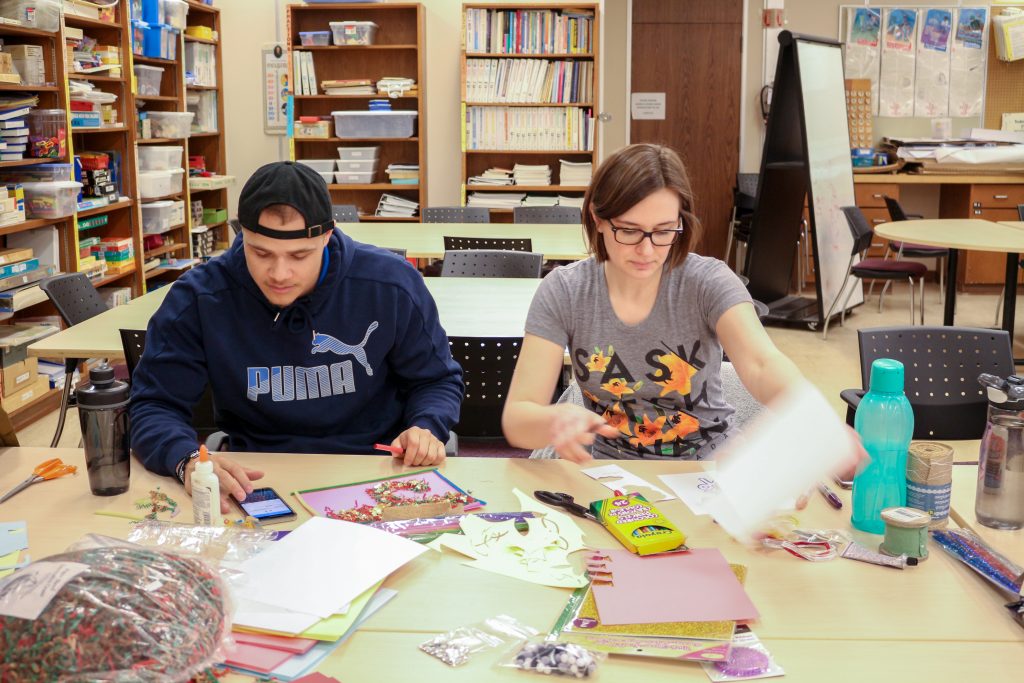


Dr. Cristyne Hébert, co-Editor of Internationalizing Curriculum Studies: Histories, Environments, and Critiques, is an Assistant Professor in the Faculty of Education at the University of Regina.
Abstract: How do we internationalize that which is deeply provincial and national? Situating our focus on and interest squarely within curriculum studies, how do we internationalize without imperializing or imposing old, colonial, and so-called “First World” conceptualizations of education on teaching, learning, and curriculum? Let us not anticipate simple answers to such complex questions. Being under no illusion that we hold Solomonic wisdom, we editors turned to the wisdom of others. A curricular response to such pedagogical questions is this edited volume. Download at https://link.springer.com/content/pdf/10.1007%2F978-3-030-01352-3.pdf
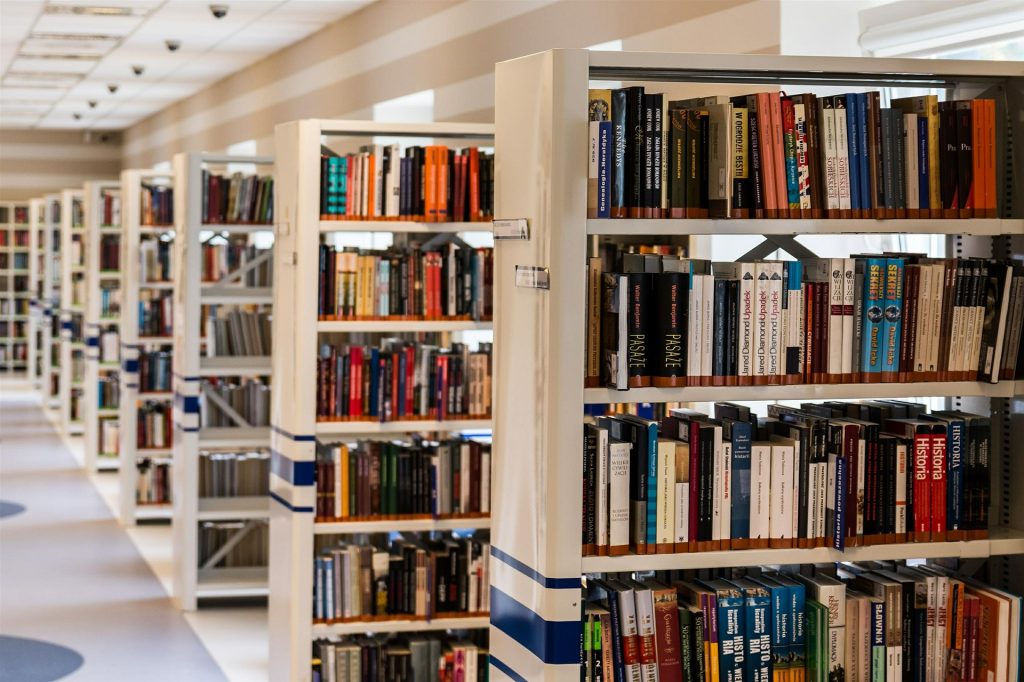
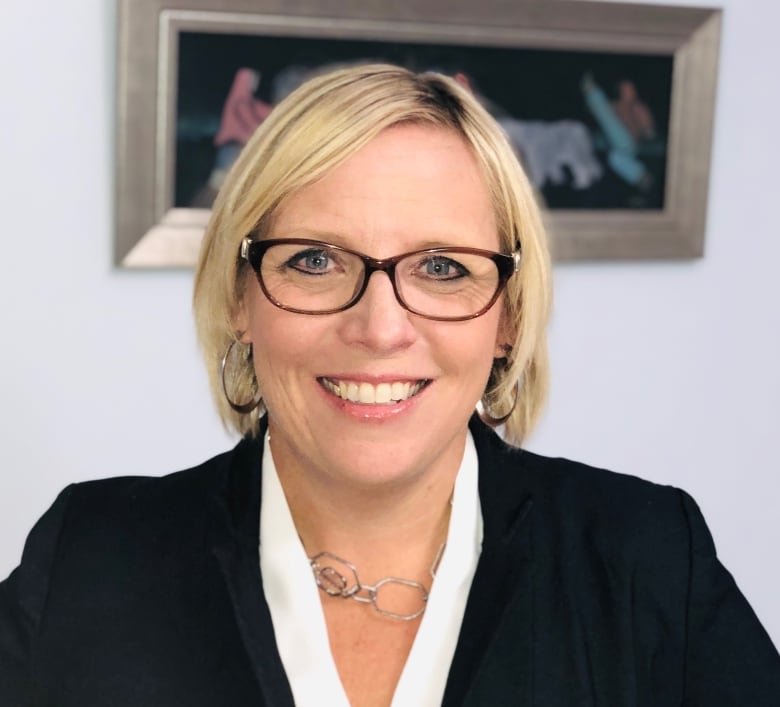
 Interview with Katherine LeBlanc (B.Ed. ’90)
Interview with Katherine LeBlanc (B.Ed. ’90)
Principal in Rankin Inlet, Nunavut at Maani Ulujuk Ilinniarvik
In January 2019, and in her 10th year of being a principal, Alumna Katherine LeBlanc was recognized as one of Canada’s Outstanding Principals by the Learning Partnership. LeBlanc grew up in Peebles, SK, went to school in Windthorst, and spent most of her career working with Horizon and Good Spirit school divisions. She and her RCMP husband “jumped at” an opportunity that would be “checked off their bucket list of to-do’s” before retirement, to go north to Rankin Inlet, Nunavut, where for the past two years, LeBlanc has served as principal at Maani Ulujuk Ilinniarvik (MUI), Kivalliq School Operations. The following is an interview with LeBlanc. The Learning Partnership states that LeBlanc in a short time has “transformed her school into a reflective, responsive to the community, safe, caring and inviting place to learn.”
Where you surprised when you found out you had won this award?
Oh yes. I knew I was nominated, but it never occurred to me that I would make the top 30. I feel there are so many deserving leaders in schools and “it is nice to just be nominated” I was overwhelmed. I shed a few happy tears and then for the next few weeks it drove me crazy not to be able to tell anyone until the announcement was officially made.
What does a day in your life as a principal in the North look like? I get to work very early. Usually I am short staffed and spend a lot of time trying to find subs. Often I can’t find them, so I spend time re-arranging schedules or my VP and I take turns going into the classes and ensuring instruction happens. If I don’t have to teach, we make sure there are snacks for our children – we have some very hungry youth. I always go say “hello” to my Elders. We have two Elders: One works helping our students make traditional tools, building igloos when the snow is just right, and helping with our land trips. Our second Elder teaches traditional sewing, skin prepping, and cooking with our students. She is also allowing us to digitally record her as we are trying to make sure we don’t lose her stories.
I try to go into every class in my school at least once a day. Sometimes it is a short visit; other times, I am doing my walk through or just helping students. I always pop into our guidance area a few times a day as this is where some of our older students need someone to talk to. Then there is the normal everyday things like checking attendance, administrative paper work, meetings, etc.
How does working in the North compare and contrast with your previous experience in the South?
I would say some of the biggest differences that I have faced are in the courses we offer. We teach students how to skin a seal and prepare it to make traditional clothing and food. We spend a full day out on the land learning how to build an igloo – for a school credit. We even take overnight land trips on the tundra in the winter! Learning about the cultural classes has been a very unique and rewarding experience. Of course, we have the similar ones, too like math, science, English etc.
How is it you’ve come to stand out in your field in such a short time?
My first goal when I got to MUI was to ensure that the students had a safe place to be. We worked hard to make sure our students felt involved in their education. One young man spoke to me about his connection with the culture and how important land trips were to him and how it has made a difference in his education. Doing my doctorate, I understood the need to work to embed culture into all we do at MUI, but hearing it from this young man made me want to help students also feel that they too were part of sustaining culture. I felt it may be a way to empower them – thus we started doing some video stories about culture.
We also shared the Inuit culture with schools in Saskatchewan. We connected via ConnectEd North into a school in Saskatchewan where my Grade 12s showcased their culture and highlighted the challenges they face up North like housing, food costs, isolation while also sharing hunting stories and cultural stories. For some of my students, they have never been out of Rankin Inlet and for others, they have never been out of the North. It was important for me to have them share their beautiful culture.
I do feel a little overwhelmed by the whole award. Honoured, but I do feel there are many principals in this nation that are more deserving. I have a great staff, students and community who are willing to work hard to meet our students’ needs and willing to work with me to ensure our students have a safe, culturally responsive environment
What obstacles or challenges have you encountered in creating the transformation at MUI? How have you overcome these challenges?
I think the biggest obstacle for me was learning about a new culture. I love the Inuit people. They have been so welcoming to me. However, my biggest concern has been my lack of knowledge about their culture. I try to engage myself with community activities, ensure Elders feel welcome in the school and try to incorporate as much traditional knowledge that I can. This means I have to rely on Elders and experts to share their knowledge not only with the students but with myself and my teachers. It can be a challenge getting some of the Elders in for many reasons. We have two that come each day and work in our traditional tools and in foods and sewing. There are many Elders in our community that can share stories but may not be able to come for various reasons, so we have tried to make them more comfortable by having teas or social events for them.
I also have attendance issues. For various reasons, there are students who do not attend. This was very unfamiliar to me. My goal was to get them in the building and make them feel welcome. If students feel part of the learning, then maybe they will stay.
I also have mental health challenges that face many of my students. We had a suicide in our community last year. I had never even met the youth, but I was devastated. I knew we needed to be resilient but also empower students to find ways to overcome these obstacles. We arranged a huge Red Cross conference for students. This focused on healthy relationships, dealing with grief, bullying, empowering themselves, etc.
Because there was an attempt for culture to be taken away during colonization, I feel it is my responsibility as a leader to try to show how important the Inuit culture is. We had Dark Spark come up and do videos and songs with our Grades 7 and 8 students. They got to write their own songs that showed the beauty of the Inuit, their traditions etc. Please check them out online and you can actually see the work my students did. Absolutely amazing!
So I guess, I am trying to overcome the obstacles by making sure I put as much culture back into the school as I can.
What is your vision for your work? What experiences informed/motivated your administrative vision?
I think my ultimate goal for my students is that they can be part of preserving our Elders’ stories and traditions. When Elders visit our classroom, they have so much knowledge that they can share. But unfortunately, these Elders will not be here forever, so it is our vision to ensure that these stories and traditions are preserved. We are slowly trying to capture their words and their language digitally. I wish it could be done faster, but to do this justice, we need to be patient.
I think my motivation comes from some of my research about mental health and loss of culture. Nunavut experiences some of the highest mental health issues in all of Canada. If we as a school can do our part to help sustain culture, then quite possibly we are helping our students feel included.
I also am fortunate to work with singer/songwriter Susan Aglukark. She has been an inspiration to me. Through her Arctic Rose foundation, she has put art therapy into our school as a means of battling mental health issues as well. Students come every day after school to do traditional art with sometimes a modern twist to it. Students have a safe space to be after school, learn a bit more about their culture and where they come from, what the story of their name is and build friendships.
What experiences have formed the passion behind your work?
Building a safe learning culture is very important to me. Students need to feel that they belong, and they are in a place where the adults in the building care about them as a whole. Colonialization is not in the distant history for the Inuit. I believe in Reconciliation and I need to do my part in this.
I also have students who are experiencing intergenerational trauma. This devastates me and each week I see evidence of the trauma some of my students are facing. Again, research states that the disconnect with culture has an impact on students and their learning. My vision is quite simply that students feel connected with their culture and education ensure that this can happen.
One reason you were recognized with this award is because of your understanding of the importance of sustaining cultural connections and pride in student and family heritage and traditions. Your focus includes the use of digital literacies and support of the Inuit language. Can you explain what you are doing and how you are using digital literacies as a way to embed culture?
We are slowly doing this. In our Inuktitut class, students are trying to video Elders and then translate their story. Our communication class has tried to highlight Inuit traditions like sewing in video. When we want to embed culture, we are trying to show connections in each of our classes with culture. For example, in science, when we talk about global warming, we look at how it specifically effects the Inuit, the caribou, etc. In shop we look at traditional tools and learn how to build them and how to use them. We try hard to incorporate Inuktitut in all of our students’ presentations. We are lucky to have two Inuktitut teachers and a school community counsellor who will help students and teachers with this. Our teachers try to find a way to embed the Inuit culture into their teachings to make it more relevant.
Do you have any mentors at the Faculty of Education, University of Regina?
I do. I was lucky to go to university with Dr. Val Mulholland. I think of her as a friend and a mentor. She is amazing at what she does and has great insight of what education should look like. She encouraged me to pursue more education than my B.Ed. I truly admired Jerry Orban. When I was an administrator in Saskatchewan, he was someone who I did contact during internship programs. He always had the time to talk and help. His passion for the internship program made me want to be more involved. I also love following Dr. Couros on Twitter. I really like the messages he sends. I also like how he engages his students via social media.
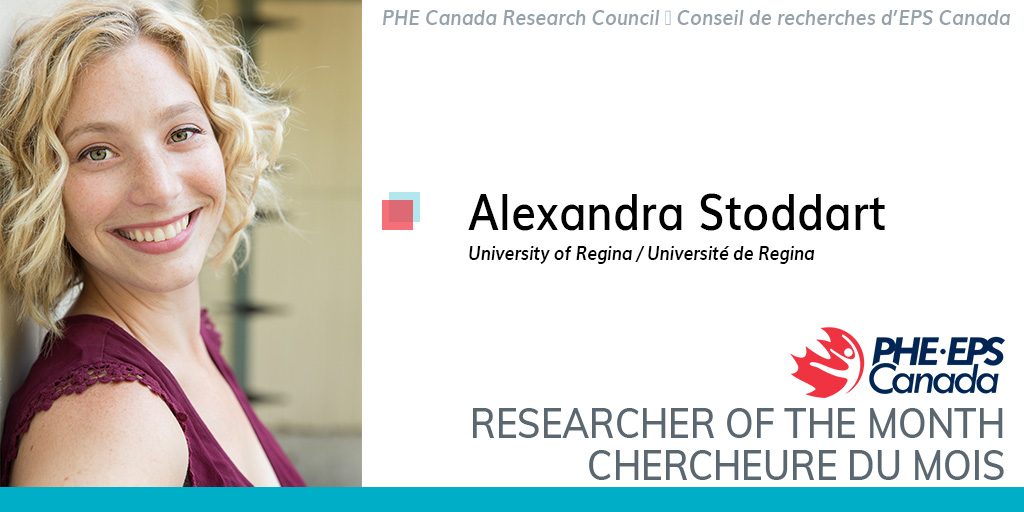
Once a month the PHE Canada Research Council selects one of its members to profile as Researcher of the Month. Whether it’s a university level teacher, academic, or graduate student, whoever is advancing research centered on topics and issues in physical and health education the Council wants to highlight. Do you know a PHE Canada Research Council member who’s professional ideals & service strengthens the physical and health education sector? Whose research & writing drives change forward? Who’s commitment and dedication to the field?

Dr. Alexandra Stoddart is an Assistant Professor in the Health, Outdoor and Physical Education (HOPE) subject area in the Faculty of Education at the University of Regina. Before joining the U of R as a faculty member in January 2018, she completed her Ph.D. in Kinesiology at the University of Saskatchewan. Alexandra currently teaches HOPE undergraduate courses in both the Elementary and Secondary programs. She enjoys the opportunity to see her students learn, grow, and thrive as they engage in their pre-internship and internship experiences.
(Source: https://phecanada.ca/connecting/research-council/researcher-month )
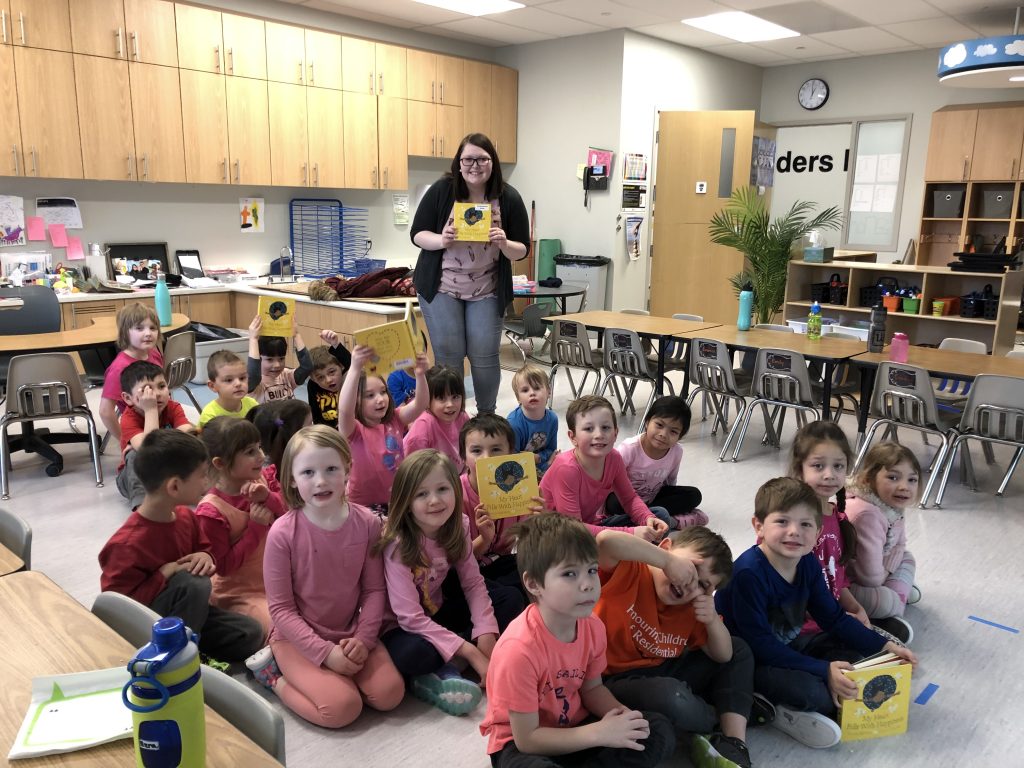
 The following story, submitted by former grad student and French Immersion Kindergarten teacher Ellen Lague and Minority Language Professor Heather Phipps, describes the development of a multilingual Saskatchewan-Belgium collaboration that evolved out of Ellen’s participation in the Social Justice and Globalization Study Tour to Belgium (EDFN 803) in July 2018.
The following story, submitted by former grad student and French Immersion Kindergarten teacher Ellen Lague and Minority Language Professor Heather Phipps, describes the development of a multilingual Saskatchewan-Belgium collaboration that evolved out of Ellen’s participation in the Social Justice and Globalization Study Tour to Belgium (EDFN 803) in July 2018.
“What Fills Your Heart with Happiness? kîkway kîya kisâkasineh mîyawhten kiteh ohcih?”
As part of my Master’s in Education program, I participated in the study tour to Belgium. The course was instructed by Dr. Heather Phipps, with whom I have shared interests in Early Childhood Education, French Immersion instruction, and literature. While in Belgium, we met with Heather’s colleague and long-time friend Caroline Moons, who instructs university students studying to become Kindergarten teachers at the University of Leuven in Belgium.
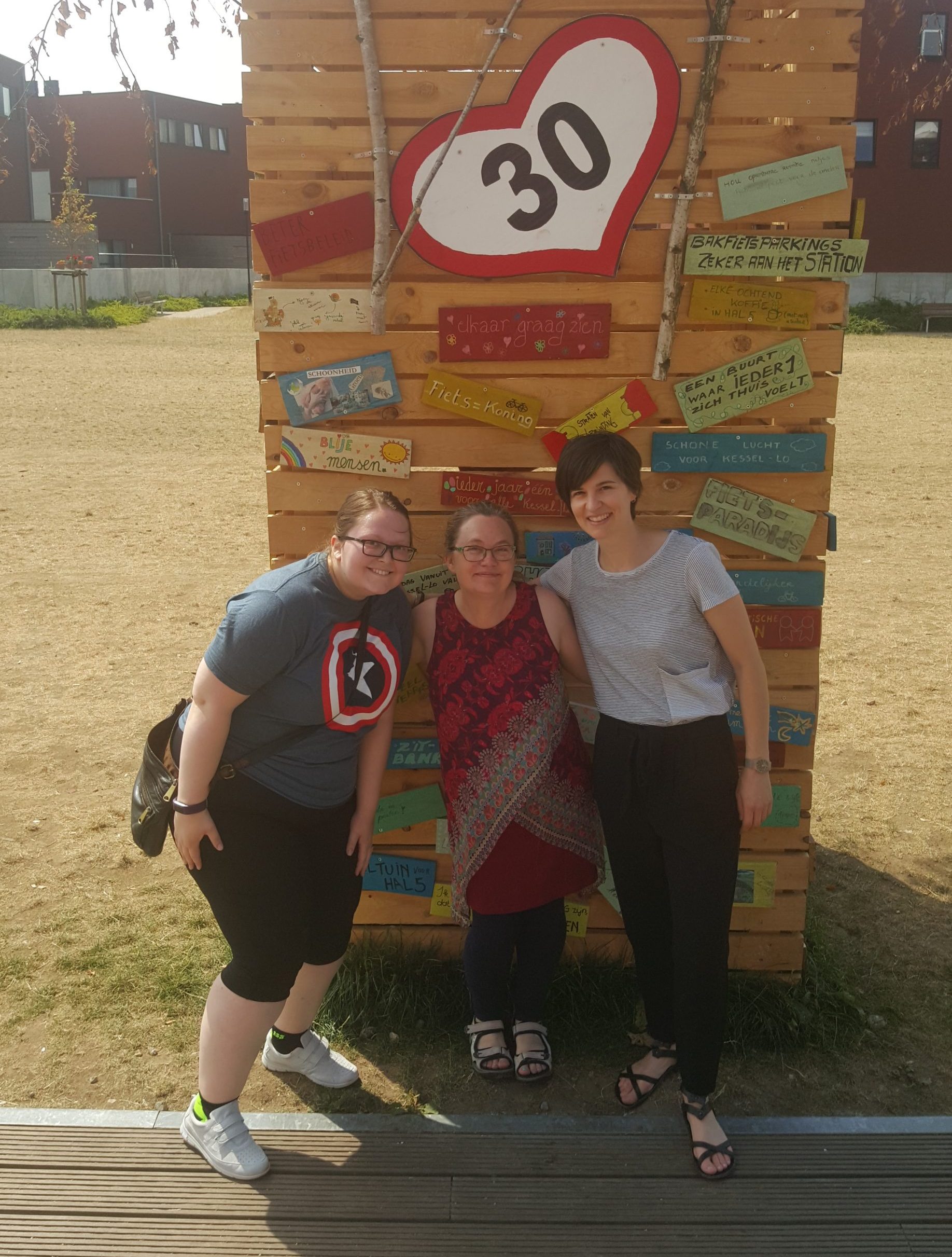 We discussed doing a multilingual project together with my Kindergarten students and Caroline’s university students. With Heather’s guidance, we chose an activity with Monique Gray Smith’s picture book My Heart Fills with Happiness/ni sâkaskineh miŷawâten niteh ohcih. Monique Gray Smith is an award-winning author of Cree, Lakota, and Scottish heritage. The picture book, written in response to the Truth and Reconciliation Commission’s Calls to Action and dedicated to IRS survivors, is a positive representation of Indigenous happiness, love, strength, and life experience. Each page, vibrantly illustrated by award-winning, Métis-Cree artist, Julie Flett, expresses the happiness experienced in the simple joys of life, such as holding the hand of someone you love or smelling fresh-baked bannock. Heather suggested this book for the multilingual reading possibility, with a Cree/English edition recently published by Orca Books.
We discussed doing a multilingual project together with my Kindergarten students and Caroline’s university students. With Heather’s guidance, we chose an activity with Monique Gray Smith’s picture book My Heart Fills with Happiness/ni sâkaskineh miŷawâten niteh ohcih. Monique Gray Smith is an award-winning author of Cree, Lakota, and Scottish heritage. The picture book, written in response to the Truth and Reconciliation Commission’s Calls to Action and dedicated to IRS survivors, is a positive representation of Indigenous happiness, love, strength, and life experience. Each page, vibrantly illustrated by award-winning, Métis-Cree artist, Julie Flett, expresses the happiness experienced in the simple joys of life, such as holding the hand of someone you love or smelling fresh-baked bannock. Heather suggested this book for the multilingual reading possibility, with a Cree/English edition recently published by Orca Books.
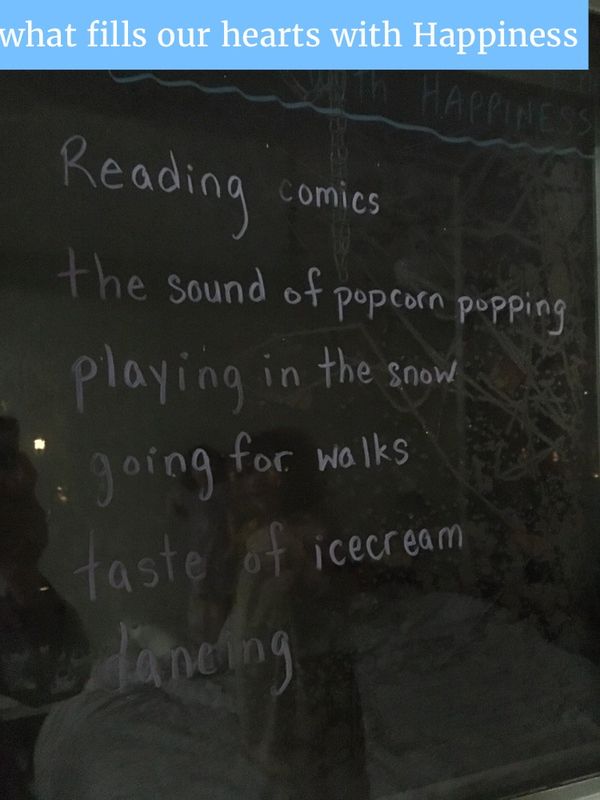 With the book chosen, my students spent most of February preparing for our project with Caroline and her students: discussing First Nation storytelling, and reading two different versions of How the Earth was Created; talking about Nanabosho or Nanabush and how he has several different names; and discussing oral storytelling and why oral stories might change in the telling, and about why February is the traditional time for storytelling because it is when the snow covers the ground. I read My Heart Fills with Happiness aloud with my students every school day in the month of February. During the break, students were asked to think about what fills their heart with happiness using specific examples. I received several responses from parents who loved the idea of our project.
With the book chosen, my students spent most of February preparing for our project with Caroline and her students: discussing First Nation storytelling, and reading two different versions of How the Earth was Created; talking about Nanabosho or Nanabush and how he has several different names; and discussing oral storytelling and why oral stories might change in the telling, and about why February is the traditional time for storytelling because it is when the snow covers the ground. I read My Heart Fills with Happiness aloud with my students every school day in the month of February. During the break, students were asked to think about what fills their heart with happiness using specific examples. I received several responses from parents who loved the idea of our project.
On February 27, students and teachers in Regina and Belgium connected through Skype. Belgian students began by asking my students about First Nations storytelling. Next, we read the book, What Fills My Heart With Happiness in four different languages: English, French, Cree and Flemish. The children knew the story so well, they were excited to hear it read in two languages that were new to them; they “oohed” and “ahhed” when hearing Cree and Flemish. Then, all the students shared what filled their hearts with happiness. One of my students mentioned speaking with her family that lives in the Philippines. Another student spoke about the sound of popcorn popping. The children were delighted to share, and the preservice teachers in Belgium also expressed their joy in meeting with the class.
For Heather, being in Ellen’s Kindergarten classroom during this multilingual reading of My Heart Fills with Happiness was a beautiful and meaningful experience. While reading together across the world and in four languages there was a feeling of interconnectedness, where each person was invited to share one’s own inner joy and to listen respectfully to others. The story is meant to be shared and makes for an ideal read-aloud. The university students listened attentively to the voices of the children in responding to the story, and the children were eager to share their knowledge and life experience. The shared interaction with the picture book inspired the children and adults to reflect on their own sources of inspiration, love, and happiness.
This spring, we were delighted to learn that the author Monique Gray Smith, alongside authors Louise Halfe and Wendy Mirasty, would be speaking on an Indigenous Author Panel at the Regina Public Library. This was a wonderful opportunity to listen to each author’s journey to becoming a writer. Monique spoke about the importance of story and how empowering it is for Indigenous readers, particularly young children, to see themselves represented in picture books. She mentioned that she has met many young readers who tell her, ‘I’m on the cover of your book.’ Furthermore, this story of sharing love and happiness ends with a significant question, “What fills your heart with happiness?” which opens up a conversation for intergenerational sharing and healing as readers of all ages are invited to reflect on love.
A journey that began in Belgium was able to take root back home. In reconnecting with Caroline we could continue the journey of reconciliation with our students, and share the
journey with students in Belgium. Two weeks after the Skype call, Heather and I shared the project with her first-year university students. To be able to culminate our project with meeting Monique Gray Smith brought happiness to my heart and a strong purpose to continue on the path to reconciliation.
By Ellen Lague and Heather Phipps
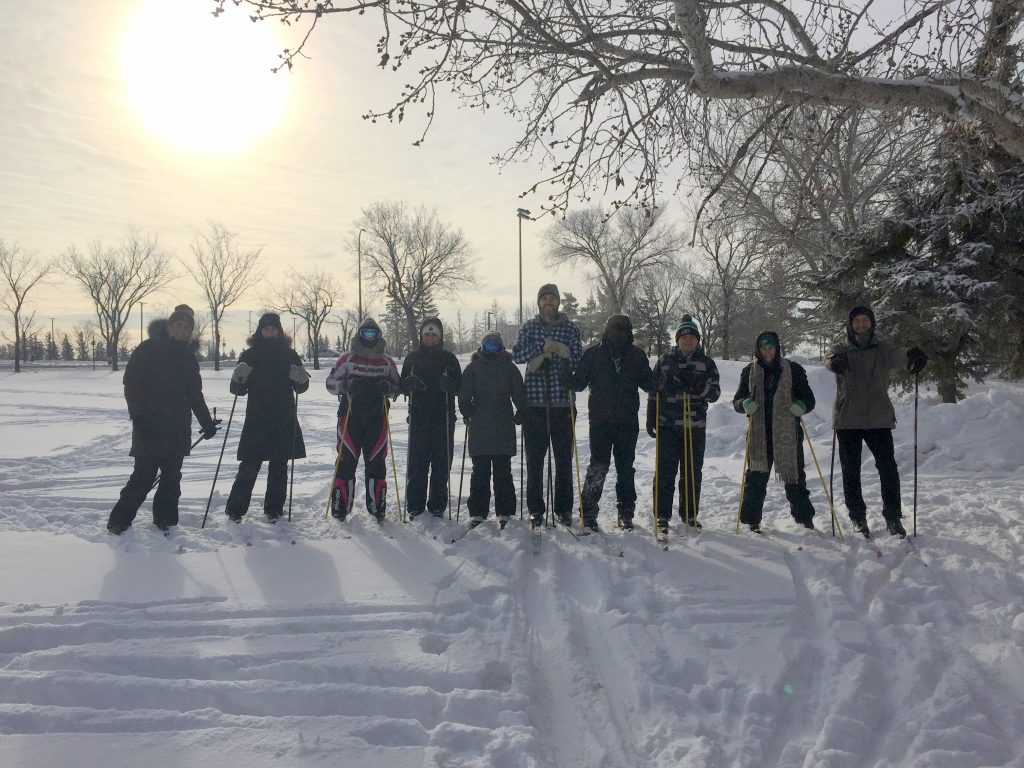
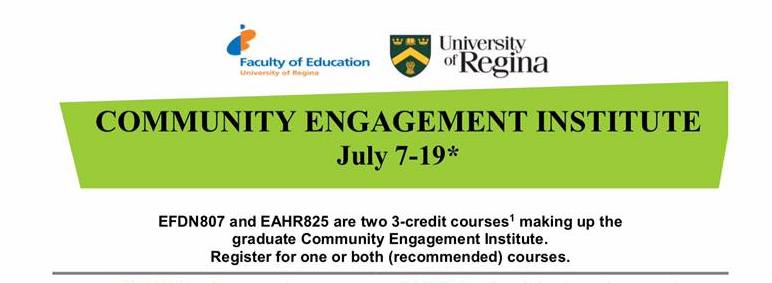
Grad students, are you making your summer plans? Consider registering for the Community Engagement Institute ( July 7 – 19). The Institute is open to all graduate students at the U of R and those attending a Canadian university under the Western Dean’s Agreement. Space is limited. See poster for details. Contact Cindy.Hanson@uregina.ca for more information.
A new book edited by Dr. Kathleen Nolan and former dean Dr. Jennifer Tupper entitled, Social Theory for Teacher Education Research–Beyond the Technical-Rational is set for release. You can pre-order your copy from Bloomsbury
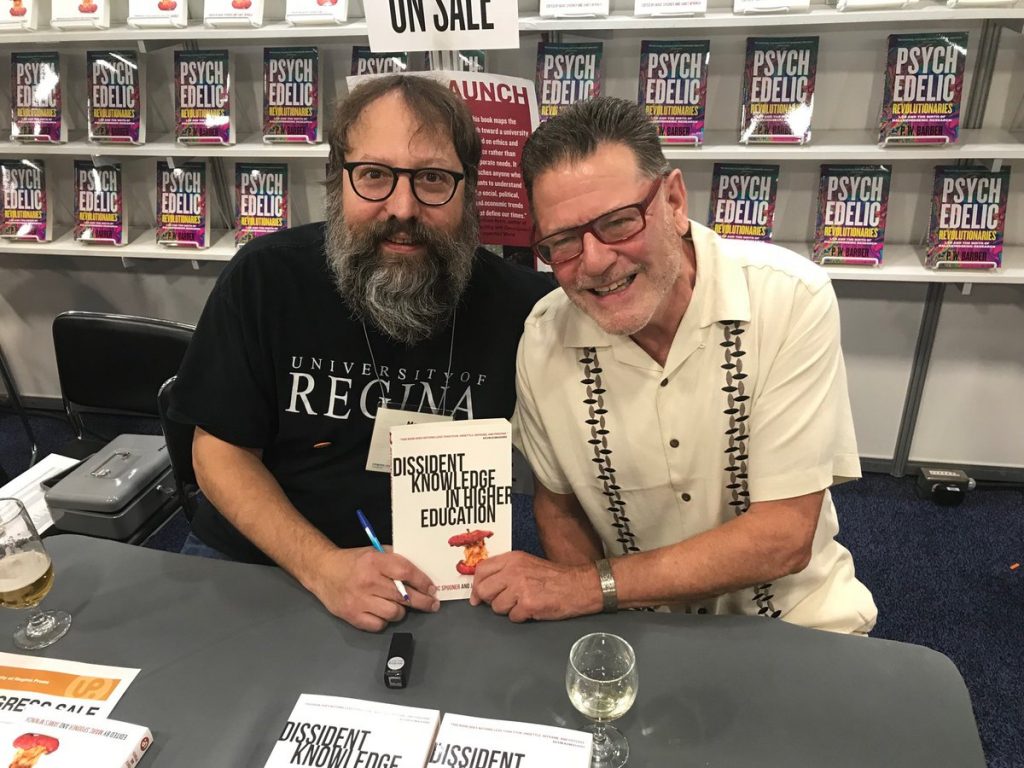
Congratulations to Marc Spooner and James McNinch, co-editors of Dissident Knowledge in Higher Education, which has been shortlisted for the 2019 Saskatchewan Book Awards, SaskBooks Publishing in Education Award, University of Regina Press. https://